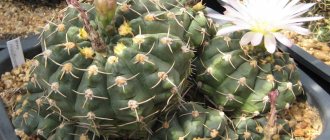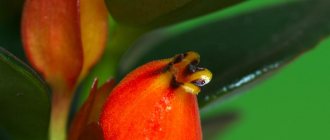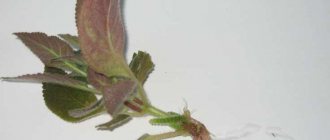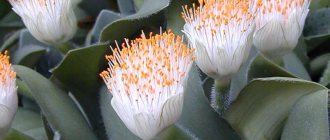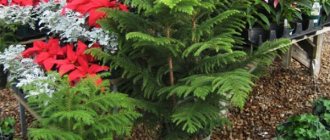An original indoor flower, stapelia, attracts attention when it is time to bloom. Its large single flowers have a beautiful regular shape, unique shades and a characteristic aroma - this is how the plant attracts flies.
It needs insects not for food, but for pollination and seed formation. There are no bees or butterflies in the regions of South Africa where the plant originates.
Description
The plant belongs to the Kutrov (Lastovnevy) family, a genus of succulents. The flowers are different, from small, up to 5 mm, to huge - 30 cm. In indoor slipways - 5-6 cm. The shape is a regular five-pointed star, reminiscent of a strongly opened bell.
Shades – fleshy burgundy, brown, beige with black stripes or specks. Some varieties have heavily pubescent flowers.
Description of the general appearance: the stems are calm shades of green, grayish-green, bluish; in the sun they can become violet-brown. They are numerous, succulent, with jagged edges, and can reach a length of 60 cm. There are no leaves.
Diseases and pests
Stapelia is one of those few indoor plants that rarely get sick and practically do not suffer from pest attacks. Therefore, we will talk about what this unusual flower can suffer from.
The main cause of diseases of the slipway is improper care and non-compliance with watering rules. In this case, the plant experiences the following problems.
| Signs of improper care | Cause | Recommendations |
| The shoots become sluggish and soft. | Root rot due to overwatering. Often appears in the cold season. | Trim healthy shoots and root. It is unlikely that it will be possible to save an adult plant. |
| The shoots become thin and long. | Lack of light and (or) mineral fertilizers. | Move to a place with plenty of light or provide artificial lighting with a phytolamp. Accustoming to more light should be done gradually. Feed with potassium or mineral fertilizers for cacti. |
| Brown spots appeared on the shoots. | Sunburn. | Accustoming to more light should be done gradually. In summer, it is recommended to shade the south window with a curtain. |
| Shriveled stems. | This is a sign of lack of moisture. | Slightly reduce the frequency of watering. |
| Stapelia does not bloom. | The resting temperature regime in winter is not ensured. | Keep in December-January at a temperature of 14-16 degrees, with virtually no watering. |
Kinds
Various types (sometimes mistakenly called varieties) of slipweeds are grown in the rooms.
| Name | Description |
| Stapelia grandiflora or grandiflora (S. Grandiflora) | The flowers are dark burgundy, star-shaped, very large – 15-20 cm. The large-flowered variety has no smell. There is a species called Stapelia tavaresia grandiflora. Despite the similar name, it has a completely different type of flowers. They look like huge long bells. |
| Stapelia variegata | Flowers are 5-8 cm, exotic, light yellow, variegated, with black speckles. The smell is quite strong. |
| Stapelia gigantea | It has huge flowers, up to 35 cm in diameter. Light yellow, abundantly covered with dark streaks. The smell is very strong, reminiscent of rotten meat. |
| Stapelia glanduliflora | The flowers are small, up to 5 cm, yellow-green, but original - very hairy. The hairs are shaped like small pins with a thickening at the end, and are white. Because of this, it seems that the flowers are abundantly covered with dew. |
| Stapelia flavopurpurea | The flowers are small in size, up to 4 cm, shape - a strongly dissected star, with very narrow elongated petals of a light green color. The petals are wrinkled, which is why their surface resembles astrakhan. The aroma is pleasant. |
| Wilman's Stapelia (Stapelia wilmaniae, or leendertziae) | Globular bright red flowers, shaped like bells, 12.5 cm long. |
| Stapelia hirsuta, or hairy (Stapelia hirsuta) | Dark red stars, abundantly covered with hairs, 5-15 cm, resemble rotting meat in both appearance and aroma. |
| Stapelia divaricata | The flowers are very smooth, waxy stars of a light cream color, turning slightly pink towards the tips of the petals, up to 4 cm. |
Stapelia cristata (f. Cristata) is a form of some species (gigantea, grandiflora, herrei), with characteristic fused stems reminiscent of sea combs.
The genus Guernia (Hurnia) is very close to slipways - more compact plants with spiky shoots and a variety of flowers of amazing shapes and colors.
general characteristics
Plants belonging to this genus are perennial low-growing succulents. The height of the plant can vary from 15 to 65 cm. The stems are multiple, living, tetrahedral, forming branches at the base. Along the edges there are massive, protruding, pointed teeth.
The most common stem color is green or gray-brown. However, with excessive exposure to sunlight, the color of the stems can turn from soft pink to reddish-purple.
Lateral shoots extending. These plants have no leaves.
The process of flowering of the slipway, which most often occurs in the summer, is fascinating. The flowers are single or paired, located on downward inclined pedicels emerging from the base of young shoots.
The size of the flower depends on the type of plant and can vary from 10 mm to 35 cm . The color of the flowers is usually variegated and varies from yellow-burgundy to lemon-orange. The corolla of the flower vaguely resembles a five-rayed star along which there are relief protrusions.
In the center of the corolla there is a middle, in the form of a convex, slightly raised roller, which was formed due to the parts of the flower fused together. This succulent is a fairly common plant both in apartments and in summer cottages.
Even with minimal care, the flower will delight you with its blooming. The homeland of slipway is eastern, southern and southwestern Africa. The plant is found in:
- SOUTH AFRICA;
- Mozambique;
- Namibia;
- Zimbabwe;
- Botswana.
The flower was discovered and named in 1737 by the Swedish explorer Carl Linnaeus. This is a separate, quite numerous genus of the Lastovnev family. There are about 100 species, not counting hybrids bred through selection.
The main feature of the slipway is its smell, which vaguely resembles the smell of spoiled food and rot, which attracts various insects, in particular flies. Flies are pollinators; they are found in large numbers in places where slipways grow.
Stapelia is common in indoor culture . Quite a fastidious plant to care for. Requires bright lighting, but can cause burns if exposed to direct sunlight.
Important : the stems of the slipway are the most important part of the plant, as they act as moisture storage and photosynthetic organs.
Caring for slipway at home
Slipways are unpretentious; they will require a minimum set of conditions. This is a great plant for busy people who don't have the time or experience. Caring for this flower at home comes down to simple rules.
Location, lighting
The plant requires bright lighting, but the stems can be damaged by direct sunlight, even causing burns. Therefore, shading will be required on a south window or balcony in the hot season.
It is not difficult to notice the lack of lighting: frail, elongated, thinned stems. Excess – purple tint to the skin and brown dry burn spots.
Temperature
In summer, the slipway will be satisfied with standard room temperature. In winter, as for any desert plants, +10...+14°C is desirable. During the dormant period, flower buds are formed. But if it is not possible to organize coolness, you can leave the plant at a temperature of +20...+25°C. The flower will not die, it will remain until spring. True, in this case you won’t have to count on abundant summer flowering.
Watering, humidity
The plant does not need abundant watering. In summer, water moderately, once a week. In winter, it is better to refrain from watering. But, if the temperature in the apartment is high and the plant has not gone to rest, it is necessary to water.
This should be done less often than in summer, once every two weeks, and it is advisable to provide lighting for the plant, otherwise the stems will become very elongated. The soil should dry well between waterings.
There is no need to spray; in extreme cases, the plant can be washed, but only if it is heavily soiled.
Feeding
The plant does not need abundant nutrition, but for better growth and flowering in the summer, you can apply any complex mineral fertilizer for indoor flowers or special for cacti.
Fertilizing is carried out several weeks before the expected flowering and during the appearance of buds.
The fertilizer is diluted with water 2-3 times compared to the dosage indicated in the instructions, so as not to burn the roots. You can water the resulting solution only on already moistened soil.
Rules for planting and transplanting
The plant is not picky about the composition of the soil mixture, but fatty mixtures with a high content of humus should not be used. Stapelia will be satisfied with ordinary soil for cacti.
The best option for planting is sandy loam with a pH of 5.5-7. Good drainage is required. Composition of the homemade mixture: turf soil (2 parts), quartz or river sand (1 part).
The pot should not be high, but wide; the root system of the stocks, unlike many plants that store moisture in the stems, does not go deep and is not active.
Fill 1/3 of the pot with drainage. When replanting, the plant is rid of old shoots in the center; they do not form flower buds.
After transplantation, the slipway does not need to be watered for 5-7 days to avoid the harmful effects of moisture on injured roots. As soon as this period has passed, the first watering is carried out.
Mature plants that feel well do not need to be replanted annually; it is enough to refresh a couple of centimeters of soil by removing the top layer and replacing it with fresh soil. Old shoots are removed.
Reproduction
Stapelia is easily propagated by both seeds and stems. The cuttings are separated from the main stem, placed in water or immediately planted in a mixture of sand and peat (ready-made soil mixture). The second breeding option is preferable. Before rooting, the cuttings are dried at room temperature for several hours (withered). This is necessary for the cut to heal.
The milky sap of the plant is poisonous and dangerous for many insects. This property forces you to work carefully with cuttings. This will not cause much harm, but may cause irritation of the mucous membranes.
Propagation by seeds is rare, but also not difficult. The seeds are quite easy to obtain at home. They are collected from elongated pods that appear on the plant from time to time. The seeds of the flower look like dandelion seeds. They are sown in spring in a mixture of sand and leaf soil, kept in a bright place at a temperature of +24°C. After 3-4 weeks, shoots will appear; they are planted in small pots for succulents (6-8 cm). After a year, the plants will be large enough to transplant into a new container for the first time.
Pests, diseases
Stapelia can be affected by aphids, mealybugs and spider mites, but this is in exceptional cases - if improper care is provided. In general, at home the plant has extremely high immunity to pests and diseases.
The only serious mistake is overwatering or overfeeding with fertilizers, or the soil being too heavy and retaining moisture. With excessive moisture, the plant begins to suffer from bacterial rot.
Peculiarities of reproduction of slipway
There are three ways to propagate a stapelia flower:
Seeds. Seeds appear in pod-like fruits - on the “star”. Seeds appear within 12 months. Seeds and grains need to be collected. There is fluff on the grains that needs to be removed. Then preparations for planting are made. To do this, you will need to immerse the seeds in a solution of potassium permanganate for half an hour. Seeds should be sown in light soil. Therefore, it is better when sand is added to the soil as soil. which allows water to pass through perfectly. After a month or a little earlier, the seeds will begin to germinate. Next comes the picking stage.
When picking, the stocks are planted from a common container into separate 6 cm pots. It is very important to adhere to the correct composition of the soil: turf, leaf, sand. The proportion is one to two for one. Add charcoal and lime in a ratio of one to eight. Next year, the sprouts can be transplanted into 7 cm pots. The plant needs basic care in its first year of life. Care should include watering, lighting, temperature, and permissible air moisture. The earth should not dry out. Flowering period for 3 or 4 years.
Stapelia also reproduces well from cuttings. To get sprouts, you need to take them from old shoots. Before planting, they are dried for 24 hours and planted. The substrate includes sand with peat chips. Over the course of a week at a temperature of 20 degrees, roots can be seen on the cuttings. Seedlings that have taken root are transplanted into 7 cm pots. The structure of the soil for planting is exactly the same as in the option of propagation by seeds. Cuttings are taken exclusively from the mother plant that bloomed. Otherwise, the plant will not set and bear fruit;
Dividing the bush. Before transplanting, divide the mother bush into a couple of parts. These plants are planted separately.

